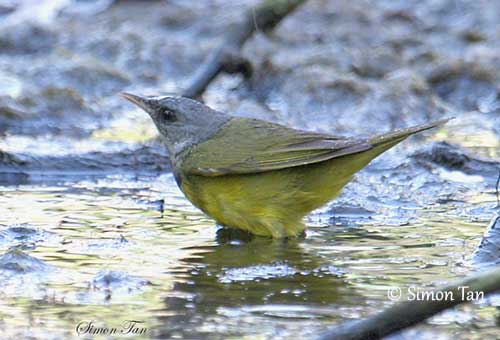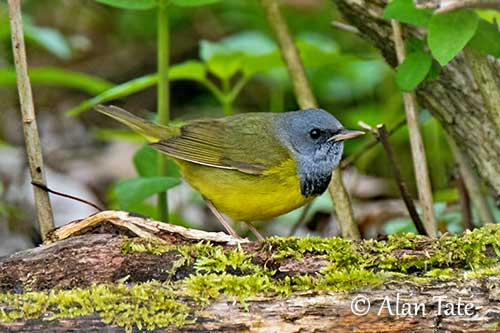
Fr: Paruline triste
Ang: Mourning Warbler
All: Graukopf-Waldsänger
Esp: Reinita Plañidera
Ita: Parula piangente
Nd: Grijskopzanger
Sd: sorgskogssångare
Photographers:
Roger Ahlman
Pbase Galleries Peru and Ecuador
Simon Tan
PBase Bird galleries
Alan & Ann Tate
AA Bird Photography
Text by Nicole Bouglouan
Sources:
HANDBOOK OF THE BIRDS OF THE WORLD Vol 15 by Josep del Hoyo-Andrew Elliot-David Christie - Lynx Edicions – ISBN: 9788496553682
FIELD GUIDE TO THE BIRDS OF NORTH AMERICA - National Geographic Society - ISBN: 0792274512
A GUIDE TO THE BIRDS OF MEXICO AND NORTHERN CENTRAL AMERICA by Steve N. G. Howell, Sophie Webb - Oxford University Press - ISBN: 0198540124
Animal Diversity Web (University of Michigan Museum of Zoology)
Birds of the Adirondack Mountains
Tennessee Wildlife Resources Agency
Natural Heritage & Endangered Species Program
SORA - A Life History of the Mourning Warbler
The life and song of a Mourning Warbler
What Bird-The ultimate Bird Guide (Mitchell Waite)
Wikipedia, the free encyclopaedia
Mourning Warbler
Geothlypis philadelphia
Passeriformes Order – Parulidae Family
INTRODUCTION:
The Mourning Warbler is a migratory species that breeds in the northern regions of North America, and spends the winter from Central America to NW South America. It is fairly common in dense undergrowth, thickets and brushy habitats when breeding, and the nest is placed on or near the ground, protected by dense vegetation.
During winter in the tropics, it can be seen in dense thickets and overgrown fields, both in lowlands and foothills. It feeds on insects and spiders caught in the low vegetation or on the ground.
The Mourning Warbler is usually hard to see as it lives near the ground all year round. The name of this bird refers to the male’s dark hood resembling a mourning veil.
The population is currently stable, and the Mourning Warbler is not globally threatened.
DESCRIPTION OF THE BIRD:
Biometrics:
Length: 12-13 cm
Wingspan: 21 cm
Weight: 13 g
The Mourning Warbler adult male has olive-green upperparts with white edges to the flight-feathers.
The underparts are yellow with olive wash on flanks.
Head, neck and upper breast are grey, with heavy black mottling on throat and chest, forming a conspicuous black bib. The lores are blackish.
The bill has pale pink lower mandible and darker upper mandible with dark culmen. The eyes are dark brown. Legs and feet are pale pinkish.

The adult female is duller than male. She has grey head, neck and upper breast whereas chin and throat are whitish. The dark eye is often surrounded by narrow, broken, whitish to pale yellow eyering.
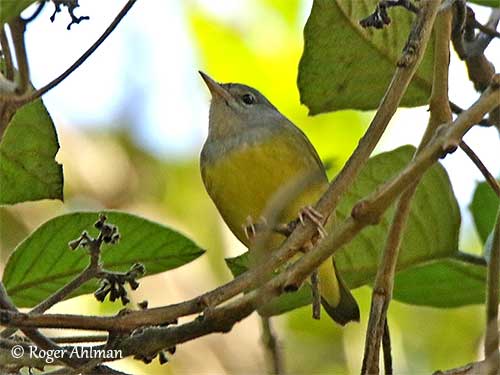
The immature resembles female, but the head is olive, throat and chest are pale yellow with greyish breast sides forming a hint of hood, especially in young male.

RANGE:
The Mourning Warbler breeds in CW and S Canada (SE Yukon and E British Columbia, E to Newfoundland and Nova Scotia), and in NE USA, S to N Illinois, N Ohio, N New England, and in Appalachians to West Virginia.
It migrates southwards to spend the winter in Central America (S from S Nicaragua) and NW South America in Colombia, W Venezuela and N Ecuador.
HABITAT:
The Mourning Warbler breeds in brushy woodland clearings and forest edges with dense undergrowth, also in dense thickets, especially aspen, birch and Prunus.
It usually prefers dense undergrowth and shrub layer typical of disturbed forests with 40/70% of canopy cover. It usually breeds at low elevations, although up to 1,000 metres in Appalachians.
During migration, it frequents a variety of woodland and scrub with dense undergrowth.
In winter, it is found in dense scrub and thickets up to 1,400 metres, but generally around 900 metres. These areas often include abandoned pastures and fields, and are frequently damp.
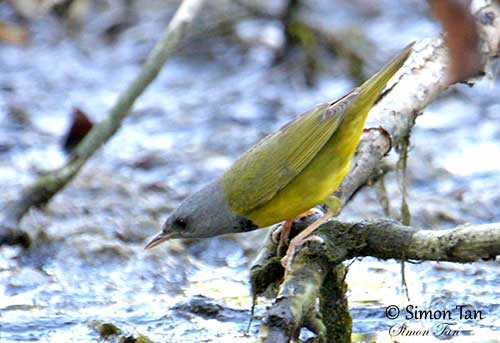
CALLS AND SONGS: SOUNDS BY XENO-CANTO
The Mourning Warbler male has two songs: the territorial song and the flight song.
The territorial song is a series of loud, slurred, rolling notes, becoming lower in pitch towards the end. It is described as “whee-o whee-o whee-o, whoo-e whoo-e”.
The flight song is rapid, with first a series of chipping notes followed by a rapid version of the territorial song “chi-chi-chi-chip-chip-cheery-cheery-cheery-chorry-chorry-chi-chip”. Only the male sings.
However, both adults give a harsh, loud “tshrip” when they are disturbed. This call is also given by the migrating warblers. The second call is a less harsh but higher-pitched “tsip”. This call is given when an intruder approaches the nest, or during a territorial fight between two females.
BEHAVIOUR IN THE WILD:
The Mourning Warbler is an insect-eater. The diet includes caterpillars, beetles, lepidopteran and other insect species, and also spiders.
The prey are caught on the ground or in low vegetation. The bird moves by hopping while foraging, and may perform short flights to catch some flying insects. It is usually alone when foraging.
During the breeding season, both adults are territorial, but the male defends the entire territory by song at the beginning of the nesting cycle. Later, the song is confined to a smaller portion of the territory.
Aggressive displays are observed against intruders, including warblers of the same species. Two males were observed hopping rapidly from perch to perch while bobbing violently their bodies. The wings were spread but the tail was closed. These displays were accompanied with frequent “tschirp” notes. Encounters between two females with winding chases are also reported.
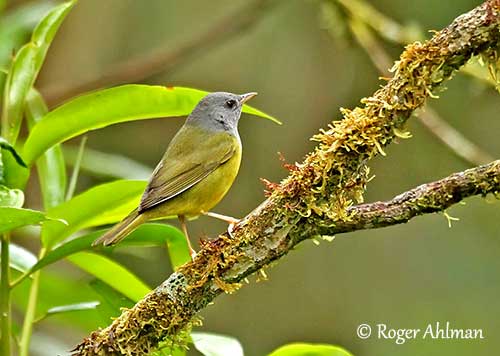
During the nesting period, both parents perform distraction displays to keep predators away from the nest. The main predators are squirrels, chipmunks and the Brown-headed Cowbird which is a parasitic species.
The nest is on or close to the ground, protected by dense vegetation. Both parents share the nesting duties.
The Mourning Warbler is migratory and moves southwards after breeding. They migrate from the northern breeding range from late July to mid-August. They migrate through Central America and arrive on the wintering grounds from mid-September.
The spring migration starts in late March, basically along the same route. They arrive on the breeding grounds from mid-May, most not until June.
The Mourning Warbler performs a swift, direct flight over short distances. The flight is fast and slightly bouncing, with rapid wingbeats. This species rarely performs extended flights.
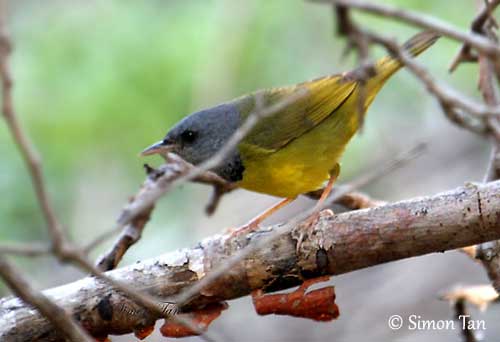
REPRODUCTION OF THIS SPECIES:
The breeding season occurs between May and early September, with the egg-laying between May and July, with peak in late June and July.
The Mourning Warbler nests on or close to the ground at base of weeds or hidden in dense tangle. The nest is a bulky, cup-shaped structure made of dead leaves and grasses, and lined with rootlets, hair and softer grass.
The female lays 3-5, usually 4 creamy-white eggs with brown markings. She incubates alone during 12-13 days, but she is fed on the nest by the male during this period.
The female was observed picking up the broken parts of an egg shell and working them with a chewing motion before swallowing them.
The chicks are fed by both parents with insects. The young leave the nest about 7-9 days after hatching, and before to be able to fly. But they depend on adults for food for another 4 weeks at least.
The nest of the Mourning Warbler is sometimes parasitized by the Brown-headed Cowbird.
PROTECTION / THREATS / STATUS:
The Mourning Warbler is usually described as “fairly common” and the population appears relatively stable, although a small decrease in North America was reported over the recent decades.
However, the species is not considered globally threatened, and the Mourning Warbler is currently evaluated as Least Concern.
